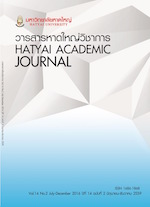การวิเคราะห์สภาพแวดล้อมในการเพาะเลี้ยงสาหร่ายผมนาง (Gracilaria spp.) ของเกษตรกรในตำบลคลองแดน อำเภอระโนด จังหวัดสงขลา
Main Article Content
Abstract
An Environmental Analysis of Pom Nang Seaweed (Gracilaria spp.) Cultivation by Farmers in Klongdan Subdistrict, Ranot District, Songkhla Province
This research aims to 1) explore farmers’ socio-economic characteristics, including cultivation and sale of Pom Nang seaweed, and 2) identify key internal and external environments affecting Pom Nang cultivation by farmers. Primary data were collected using structured interviews, non-participant observations, natural conservations and in-depth interviews with a total of 30 Pom Nang seaweed cultivators. Purposive selection and snowball sampling were used for data selection. In addition, structured interviews were used with government officers and Pom Nang seaweed wholesalers. The derived data was analyzed using percentage, arithmetic mean, manifest content analysis and SWOT analysis techniques. The results showed that a subsidiary occupation of most farmers was Pom Nang seaweed cultivation with an average experience in Pom Nang seaweed cultivation of approximately three years. The Pom Nang seaweed was sold to wholesalers. The dominant strength was farmers had reasonably good know-how of Pom Nang seaweed cultivation, whereas, the dominant weakness was farmers lacked modern technology. The dominant opportunity was that there were high demands for Pom Nang seaweed, while the dominant threat was there were a few research about Pom Nang seaweed cultivation. To enhance the development of Pom Nang seaweed cultivation, this research suggests promotion of Pom Nang seaweed cultivation, an alternative occupation for farmers, and its processing.
Article Details
All submitted articles are subject to academic validation by qualified experts (peer review). The opinions expressed in each article of this publication are those of the authors themselves. The editorial board holds no responsibilities on them and does not reserve the copyright for academic use with the condition that the reference of their origin is cited.
